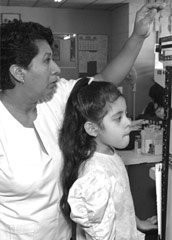| December 2008 Edition |
World Health Report 2008
Primary Health Care: The Best Cure for Failed Systems

Countries whose health systems are organized around the principles of primary health care produce better health outcomes than other countries at the same level of economic development, according to Primary Health Care: Now More than Ever, WHO's 2008 World Health Report. Photo by Harold Ruiz/PAHO
Health systems around the world are failing to meet the needs of the people they are supposed to serve, a failure that is now becoming "a threat to social stability," says the 2008 World Health Report, Primary Health Care: Now More than Ever.
The failures are producing rising health costs at the same time as growing inequities in health status and access to services. The best solution, says the report, is systemic reform centered on primary health care.
"A world that is greatly out of balance in matters of health is neither stable nor secure," said World Health Organization (WHO) Director-General Margaret Chan at the launching of the 2008 World Health Report in Almaty, Kazakhstan, in mid-October. "The World Health Report sets out a way to tackle inequities and inefficiencies in health care, and its recommendations need to be heeded."
"To effectively meet new challenges, such as high energy costs, the food crisis, climate change and now the financial crisis... we need a new effort to strengthen health services based on primary health care," said Pan American Health Organization (PAHO) Director Mirta Roses Periago in Almaty in an interview with United Nations Radio.
The World Health Report's release marked the 30th anniversary of the 1978 Alma-Ata International Conference on Primary Health Care, which first brought primary health care to prominence on the global scene. The approach was seen at the time as a revolutionary model for organizing and delivering health care, aimed at countering gross inequities in health status and access to care.
Since then, the approach has evolved in significant ways, while health inequities have increased around the world. "Now more than ever," the report argues, primary health care is the best set of principles for organizing health-care systems. The report shows that in countries at the same level of economic development, health systems organized around primary health care principles have produced better health results than those that are not.
"Thirty years of well-monitored experience tell us what works and where we need to head in rich and poor countries alike," said Chan.

Primary health care, say top public health experts, is the best way to get health care systems back on track. Photo by DavidSpitz/PAHO
The 2008 World Health Report documents striking inequities today in health status and access to care in different countries and for different population groups.
The gap in life expectancy between the richest and the poorest countries is now more than 40 years. Four out of 10 women worldwide who will give birth this year will receive no medical assistance during or after childbirth, endangering their lives and those of their babies. Government expenditures on health vary from as little as $20 per person in poor countries to well over $6,000 per person in wealthier ones. Inequities are also great within countries.
The root causes of these problems are not just lack of funds but also the way health systems are organized. Conventional healthcare delivery systems have not adapted well to changing social, epidemiological, and economic conditions and instead "seem to be drifting from one short-term priority to another, increasingly fragmented and without a clear sense of direction," says the report. "Health systems are developing in directions that contribute little to equity and social justice and fail to get the best health outcomes for their money."
The report lists five common shortcomings of healthcare delivery around the world that need to be overcome
Inverse care. Public health spending on health services tends to benefit the rich more than the poor. People with the most means consume the most care, while those with scarce means and greater health problems consume the least.
Impoverishing care. Because of the lack of social protection schemes, over 100 million people annually must pay their healthcare expenses out of pocket, and they often fall into poverty as a result.
Fragmented care. Excessive specialization by physicians and the narrow focus of many disease control programs discourage a holistic, continuous approach to health. Health services for the poor are often highly fragmented and under-resourced, with development aid often adding to the fragmentation.
Unsafe care. Poor system design too often fails to ensure safety and hygiene standards, which leads to high rates of hospital-acquired infections as well as medication errors and other adverse events--all underestimated causes of death and illness.
Misdirected care. Resources are concentrated in curative services at the expense of primary prevention and health promotion, which could prevent up to 70 percent of illnesses and deaths.
All these problems need to be addressed through sweeping reforms based on primary health care, in areas ranging from migration of healthcare workers to financing of health services and empowering healthcare consumers to influence health policy.
The report describes changes in the primary care approach that have emerged based on experiences with early attempts to implement the model.These include a new emphasis on primary health care as a comprehensive response to people's health needs rather than a separate program to provide cheap care for the poor, and a focus on transforming existing health systems with the aim of achieving universal access to protection and care.
"Viewed against current trends, primary health care looks more and more like a smart way to get health development back on track," said Chan.
|
Previous: Contents page
|